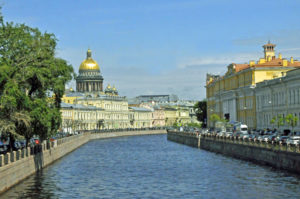
Neva River in St. Petersburg, Russia (Photo by Don Knebel)
In 1703, 31-year-old Tsar Peter I founded a port on a marshy area at the eastern end of the Gulf of Finland that he had captured from Sweden. The port, along the Neva River, gave Russia access to the Baltic Sea. To protect the port from a feared counter attack, Peter built a fortress on an island in the Neva River that he named for Saints Peter and Paul. A city developed around the fortress, expanding onto other islands. Peter named his new city Sankt-Petersburg, a German formulation honoring St. Peter as patron. Having become fascinated with European culture and architecture during an 18-month visit to European capitals, Peter gave his city a distinctively European look, with classical façades and broad canals. Peter, known to history as Peter the Great, made St. Petersburg the capital of Russia in 1712.
In 1914, after war broke out with Germany, the city’s name was changed to the Russian-sounding Petrograd, with Peter I now its patron. In 1924, after the Russian Revolution, the Bolsheviks renamed the city Leningrad. After the fall of Communism, the city regained its original name after a public vote in 1991.
Today, St. Petersburg is the second largest city in Russia, home to more than five million people. The historic area around the Peter and Paul Fortress is preserved as a UNESCO World Heritage site, with large buildings prohibited. St. Petersburg is home to at least 220 museums, including the one-of-a-kind Hermitage, and more than 2000 libraries. Its many colorful churches include St. Issac’s, the third largest domed cathedral in the world. Because of its network of canals and rivers, the city is one of several dubbed the Venice of the North. St. Petersburg is not Moscow’s Russia.